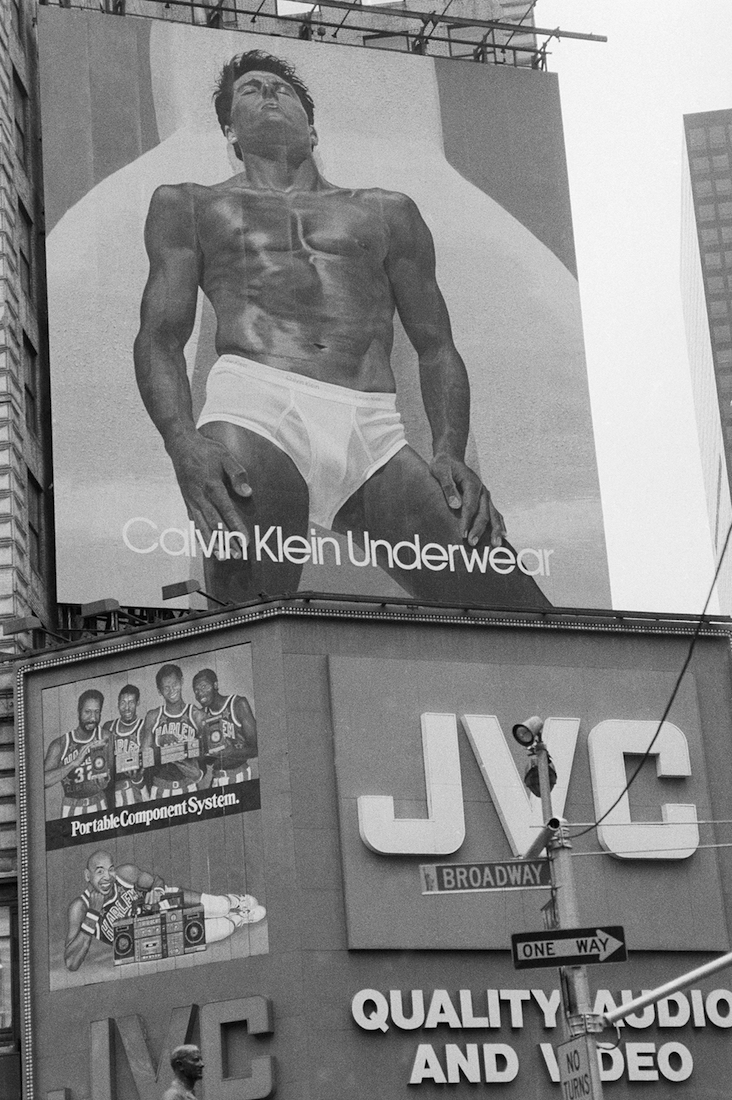It’s a perfect irony that two years before Calvin Klein introduced the concept of designer underwear to the world, he scandalized America with a denim commercial that advocated going commando. “You wanna know what comes between me and my Calvins?” asked a 15-year-old Brooke Shields, in a girlish whisper. “Nothing.” But then, the legacy of Calvin Klein underwear has everything to do with irreverence, controversy, and inspired advertising.
In 1982, with a single image — Bruce Weber’s iconic shot of Olympic pole-vaulter Tomás Hintnaus, muscles stretched out across a whitewashed Santorini rooftop — Klein transformed cotton Y-fronts from a faintly repellent multipack necessity into something lust-worthy. The company ran the suggestive image on 25 New York City bus shelters, and overnight, the glass displays of each one was smashed, the posters stolen. Stores couldn’t keep the style in stock for long enough to meet demand. And more than 30 years later, in 2016, the iconic-logoed waistband is more present and powerful than ever. Today, the Instagram hashtag #mycalvins has racked up more than 300,000 self-published images of 20-somethings (celebrities and civilians alike) posed in nothing but their CKs.
WATCH i-D’s interview with Calvin Klein.
Why the insane staying power? “The only way to advertise is by not focusing on the product,” Klein once said, and he’s built his underwear empire on this piece of strategic sleight of hand. Calvin Klein’s boxers, bras, and briefs are never the focal points of the ads in which they appear; they’re the fig leaves that allow us to look at nearly naked Brazilian athletes while we wait for the bus or stare at Lara Stone’s breasts, blown up across a 20-foot billboard in New York’s SoHo. And the controversy surrounding the ads — Klein has been accused of promoting everything from child pornography to sexual assault — has only added fuel to the fire.
Then there’s the roll call of pop-world talent Klein has enlisted, and the legendary fashion photographers he’s recruited to capture them, from Herb Ritts to Peter Lindbergh. The most recent Calvin Klein underwear campaign, for spring 2016, is a time capsule of contemporary celebrity, ranging from rappers Kendrick Lamar and A$AP Rocky to models Kendall Jenner and Abbey Lee. Justin Bieber also makes a repeat appearance, after sparking controversy in 2015 with a conspicuously robust bulge beneath a pair of… was it boxers or briefs? If you can’t remember, that’s exactly the point. The overt sexuality of the ads has become almost a parody of itself, and in this campaign’s case, Saturday Night Live took full advantage. In a sketch, Kate McKinnon played Bieber looking flirtatiously into the camera and simply stating, “My pee-pee’s in there.” As the Bieber crotch debacle illustrates, Calvin Klein’s ads capitalize on the underwear’s real power: its ability not to steal its models’ thunder.
In that sense, a pair of CK briefs checks off the last and perhaps most important of Dieter Rams’s ten principles for good design: “Good design is as little design as possible.” The pair of fitted boxers modeled by Mark “Marky Mark” Wahlberg in his endlessly watchable 1992 Calvin Klein commercial, or the high-waisted briefs worn by his co-star, Kate Moss, have lines so clean it’s impossible to imagine underwear looking any other way. The styles are not just classic but almost impossible to improve.
They are also the exact opposite of traditionally “sexy” undergarments. Instead of black lace, ribbons, and ruching, they have a functional elasticated waistband, woven with a (not particularly evocative) man’s name. That these distinctly basic garments have become symbols of American eroticism is entirely against the odds. But like the Campbell’s Soup can, the Calvin Klein brief has transcended the question of any innate allure to become an object of mass fetishizing. There is something intrinsically American about a Calvin Klein boxer short, actually faintly puritanical with all its echoes of corn-fed athleticism (see: the brand’s newest face, or rather body, the Fayetteville, Georgia-raised model Mitchell Slaggert). And in 2016, when the idea of the gender binary is rapidly falling away, the neutrality of a purposefully unadorned, almost utilitarian undergarment feels fresher than ever.
This article appears in the May issueof VICE Magazine. Click HERE to subscribe.
Credits
Text Alice Newell-Hanson
Photograph Getty Images
